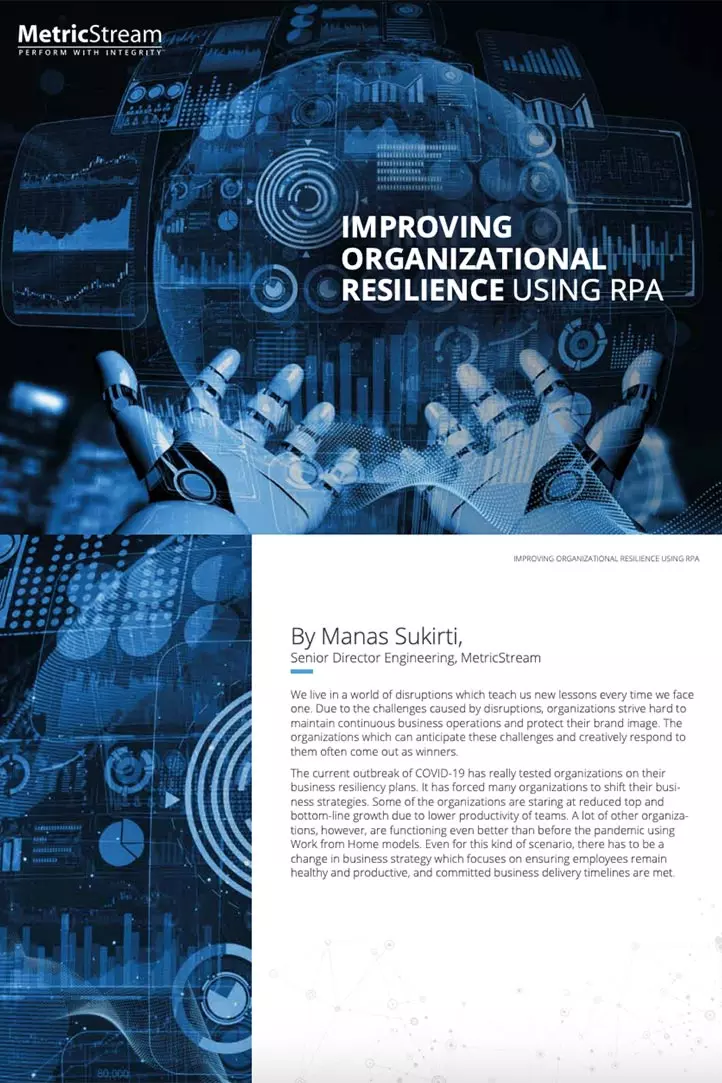ConnectedGRC
Drive a Connected GRC Program for Improved Agility, Performance, and Resilience
-
BusinessGRC
Power Business Performance and Resilience
Discover ConnectedGRC Solutions for Enterprise and Operational Resilience
Explore What Makes MetricStream the Right Choice for Our Customers
Discover How Our Collaborative Partnerships Drive Innovation and Success
- Want to become a Partner?
Find Everything You Need to Build Your GRC Journey and Thrive on Risk
Learn about our mission, vision, and core values
Improving Organizational Resilience using RPA
We live in a world of disruptions which teach us new lessons every time we face one. Due to the challenges caused by disruptions, organizations strive hard to maintain continuous business operations and protect their brand image. The organizations which can anticipate these challenges and creatively respond to them often come out as winners. The current outbreak of COVID-19 has really tested organizations on their business resiliency plans. It has forced many organizations to shift their business strategies. Some of the organizations are staring at reduced top and bottom-line growth due to lower productivity of teams. A lot of other organizations, however, are functioning even better than before the pandemic using Work from Home models. Even for this kind of scenario, there has to be a change in business strategy which focuses on ensuring employees remain healthy and productive, and committed business delivery timelines are met.

One thing which the pandemic has ensured is that uncertainty is going to continue for some time, and that no one is able to predict for how much longer. Some of the factors which this uncertainty has created are: • Increased online transactions – Consumers are ordering more than ever via the web leading to an increase in cashless transactions.
• Increased demand for high speed data – While working from home, employees are switching to better data plans which can allow them to work effectively.
• Increased automation – Enterprises are scouting for opportunities where manual work can be replaced via automation and thus allowing digital workforces to take shape.
In today’s environment, enterprises need more automation than ever before. Robotic Process Automation (RPA) plays a key role in helping enterprises tap opportunities of automating the business processes. In case, you are new to RPA, you can refer to an article about RPA and its journey here. The bots created using an RPA system can function 24×7 which increases their productivity, accuracy and effectiveness. A point to note here is that RPA is suitable for processes which are driven by rules and which an enterprise needs to perform repeatedly.
A recent survey by an RPA enterprise called Automation Anywhere revealed the following findings:
• Nearly 50 percent of firms plan to invest in RPA to increase business resiliency in the post-COVID world. The pandemic and its aftermath have catapulted the urgency for embracing digital technologies.
• More than 70 percent of survey respondents said they anticipate at least half of their workforce will be digital workers, while more than one quarter expect more than 80 percent of their workforce to become digital.
From a GRC standpoint, there are many use cases of RPA which an enterprise can adopt:
• Full-Scale Automated Auditing – The traditional audits focused on auditing based on random sample sizes. It’s difficult to manually audit all the samples available. Random sample auditing, though helpful, can at times lead to missing out on some key samples which can alter audit findings. RPA solves this problem as the bots can perform full-scale auditing rather than focus only on random samples. Bots can pull up evidence and indicate cases of non-conformance automatically.
• Risk Assessment – RPA can help organizations gather data from various disparate systems. Using this data, the internal systems can do risk classification and perform trend analysis; thereby, effectively predicting the various outcomes which can help a risk manager plan for mitigations.
• Control Testing Automation – Bots can be made capable of performing control testing. This is helpful in both audits and compliance management.
• Continuous Control Monitoring – RPA can automatically collect the data from multiple systems and access the controls. Alerts can be generated when exceptions are found.
• Automated Third-Party Due Diligence – RPA can also be used during third party due diligence as it can gather data about third parties from various sources. This data can then, in turn, be used to influence the decisions to onboard a third party into the system.
In addition to the GRC use cases above, there are many others which RPA can handle. Those include Insurance Claim Processing, Performing KYC Checks, Loan Origination, Purchase Order Management, Invoice Processing, and many more.
By allowing the automation of business processes, RPA not only improves productivity but also helps in containing costs for an organization. With or without the current pandemic, it makes sense for organizations to embrace RPA as it gives them an advantage in improving their business process efficiencies. It also helps the organization become more resilient by focusing on improving efficiencies via automation. RPA is also useful in executing business continuity planning during these times of uncertainty. Organizations should look deeply within and identify the repetitive manual processes, business challenges and risks they face. They can then analyze how RPA can help mitigate those.
Adopting RPA will not only improve the agility of an organization but also provide an opportunity to improve business resiliency. The need for automating manual repetitive business processes was always there. The pandemic just accelerated it and brought automation to the center stage.
Read Related Policy Measurement and Evaluation Article

Subscribe for Latest Updates
Subscribe Now






